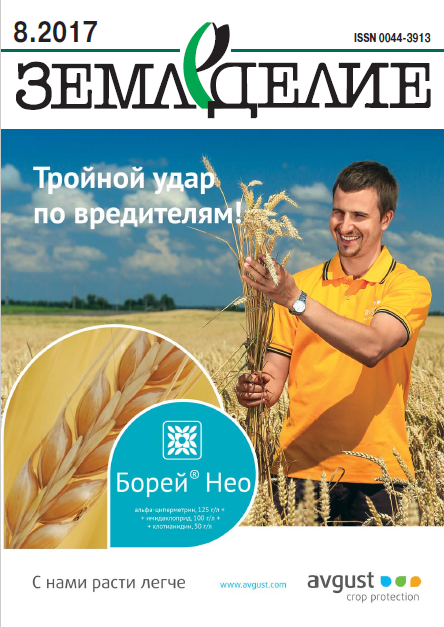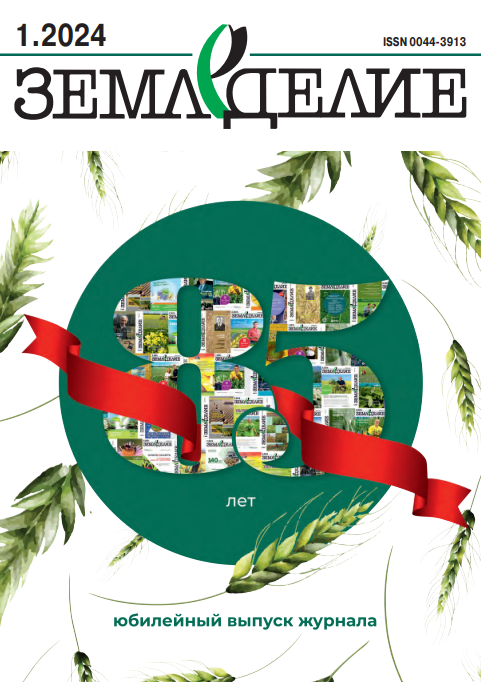Влияние удобрений на пищевой режим почвы и химический состав зерна гибридов кукурузы
УДК 633.15
П.А. ЧЕКМАРЕВ (1), доктор сельскохозяйственных наук, академик РАН, директор департамента
В.Н. ФОМИН (2), доктор сельскохозяйственных наук, профессор
С.Л. ТУРНИН (2), аспирант
(1) Министерство сельского хозяйства Российской Федерации, Орликов пер., 1/11, Москва, 107139, Российская Федерация
(2) Татарский институт переподготовки кадров агробизнеса, ул. Оренбургский тракт, 8, Казань, 420059, Российская Федерация
Представлены результаты изучения влияния минеральных удобрений на пищевой режим почвы, химический состав зерна и вынос элементов питания при выращивании различных гибридов кукурузы. Опыт проводили в 2014-2016 гг. в Чистопольском районе Республики Татарстан. Предшественник – озимая пшеница. Определяли содержание элементов питания по фазам развития кукурузы, химический состав зерна и вынос элементов питания с урожаем. Метеорологические условия в годы проведения исследований, несмотря на неравномерное выпадение осадков и колебания температуры, в целом были благоприятными для роста и развития кукурузы, лучшие условия складывались в 2015 г. Поглощение элементов питания кукурузой происходит в течение всей вегетации. На химический состав зерна большее влияние оказали удобрения и метеорологические условия, меньшее – генотип гибрида. В среднем за 3 года содержание азота в зерне на фоне естественного плодородия почвы варьировало от 1,53 до 1,65 %, фосфора – от 0,42 до 0,52 %, калия – от 0,53 до 0,63 %. При внесении удобрений в рассчете на 6 т/га, величины этих показателей возросли до 1,68-1,86, 0,51-0,61 и 0,70-0,82 % соответственно. У гибрида РОСС 195 МВ на фоне естественного плодородия почвы, в среднем за 3 года, вынос азота на 1 ц зерна составил 2,69 кг, фосфора – 0,98 кг и калия – 3,41 кг. С внесением доз минеральных удобрений, рассчитанных на получение 6 т/га зерна, он возрастал до 3,13, 1,11 и 4,37 кг/ц соответственно. Вынос элементов питания единицей урожая увеличивался по мере повышения показателя ФАО. Самым низким, как в контроле, так и на расчетном фоне питания он был у гибридов РОСС 140 СВ и Нур, самым высоким (азота – 3,14 кг/ц, фосфора – 1,15 кг/ц, калия – 4,35 кг/ц) – у гибрида Каскад 195 СВ.
Ключевые слова: кукуруза, удобрения, гибрид, продуктивность, урожайность, почва, пищевой режим, химический состав.
Для цитирования: Чекмарев П.А., Фомин В.Н., Турнин С.Л. влияние удобрений на пищевой режим почвы и химический состав зерна гибридов кукурузы // Земледелие. 2017. № 8. С. 14-17.
Influence of Fertilizers on Nutritional Conditions of Soil and Chemical Composition of Grain of Corn Hybrids
P.A. Chekmarev(1), V.N. Fomin(2), S.L. Turnin(2)
(1) Ministry of Agriculture of the Russian Federation, Orlikov per., 1/11, Moskva, 107139, Russian Federation
(2) Tatar Institute of Professional Development in Agribusiness, ul. Orenburgskii trakt, 8, Kazan’, 420059, Russian Federation
Abstract. It is presented the results of the study of the influence of mineral fertilizers on the nutritional regime of soil, the chemical composition of grain and carry-over of nutrients at the cultivation of different corn hybrids. The experiment was carried out in 2014–2016 in Chistopolsky district of the Republic of Tatarstan. The forecrop was winter wheat. We determined the content of nutrients in different development phases of corn, the chemical composition of grain and the carry-over of nutrients with the harvest. Meteorological conditions in the years of the experiment, in spite of uneven precipitation and temperature fluctuations, were generally favorable for the growth and development of corn. The best conditions were in 2015. Absorption of nutrients by corn occurs throughout the entire growing season. The chemical composition of the grain was more influenced by fertilizers and meteorological conditions, less – by the genotype of the hybrid. On average over 3 years nitrogen content in grain against the background of natural soil fertility ranged from 1.53 to 1.65%, phosphorus – from 0.42 to 0.52%, potassium – from 0.53 to 0.63%. At the application of fertilizers for the yield of 6 t/ha, the values of these parameters increased to 1.68–1.86, 0.51–0.61 and 0.70–0.82%, respectively. In ROSS 195 CF hybrid against the background of natural soil fertility, on average for 3 years, the carry-over of nitrogen per 100 kg of grain amounted to 2.69 kg, phosphorus – 0.98 kg and potassium – 3.41 kg. With the application of doses of mineral fertilizers calculated to produce 6 t/ha of grain, it increased to 3.13, 1.11 and 4.37 kg/100 kg, respectively. The carry-over of nutrients by the unit of yield increased with the increase in the FAO indicator. The lowest against the control and the calculated backgrounds of nutrition it was in ROSS 140 SV and Nur hybrids, the highest (nitrogen – 3.14 kg/100 kg, phosphorus – 1.15 kg/100 kg, potassium – 4.35 kg/100 kg) – in Kaskad 195 SV hybrid.
Keywords: corn; fertilizers; hybrid; productivity; yield; soil; nutritional regime; chemical composition.
Author Details: P.A. Chekmarev, D. Sc. (Аgr.), member of the RAS, director of division; V.N. Fomin, D. Sc. (Аgr.), prof.; S.L. Turnin, post graduate student.
For citation: Chekmarev P.A., Fomin V.N., Turnin S.L. Influence of Fertilizers on Nutritional Conditions of Soil and Chemical Composition of Grain of Corn Hybrids. Zemledelie. 2017. No. 8. Pp. 14-17 (in Russ.).










